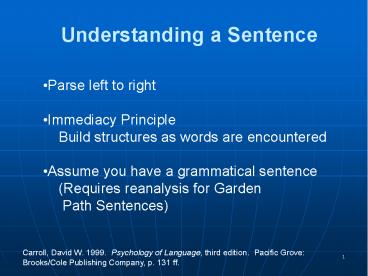Understanding a Sentence PowerPoint PPT Presentation
Title: Understanding a Sentence
1
Understanding a Sentence
- Parse left to right
- Immediacy Principle
- Build structures as words are encountered
- Assume you have a grammatical sentence
- (Requires reanalysis for Garden
- Path Sentences)
Carroll, David W. 1999. Psychology of Language,
third edition. Pacific Grove Brooks/Cole
Publishing Company, p. 131 ff.
2
Left to Right Parsing Ambiguities
- The old yellow ship can float .
- Art N N N N N
- Adj Adj V V V
- V Mod
3
Garden Path Sentences
- 1. The florist sent the flowers was very
pleased - 2. Since Jay always jogs a mile seems like a
very short distance to him.
Carroll, David W. 1999. Psychology of Language,
third edition. Pacific Grove Brooks/Cole
Publishing Company, pp. 132-133.
4
Late Closure
- 1. Tom said that Harry took the trash out
yesterday. - 2. James put the book Marie was reading in
the library - on the table.
- 3. Fiona discovered on Monday the penguin had
hurt - its foot.
- 4. The man the girl the boy met believed
laughed.
Carroll, David W. 1999. Psychology of Language,
third edition. Pacific Grove Brooks/Cole
Publishing Company, p. 133. Aitchison, Jean.
1998. The Articulate Mammal An Introduction to
Psycholinguistics. London Routledge, pp.
211-212.
5
Late Closure(Newspaper Headline)
- Ban on Nude Dancing on Governor's Desk
Leno, Jay. Headlines.
6
Late Closure (Frank and Ernest)
Ashcraft, Mark H. 1994. Human Memory and
Cognition, second edition. New York Harper
Collins College Publishers, p. 432.
7
Minimal Attachment
- 1. Ernie kissed Marcie and her sister
- 2. The city council argued the mayor's position
- forcefully.
- 3. The city council argued the mayor's
position - was correct.
- 4. The lion paraded through the town escaped.
Carroll, David W. 1999. Psychology of Language,
third edition. Pacific Grove Brooks/Cole
Publishing Company, p. 134. Aitchison, Jean.
1998. The Articulate Mammal An Introduction to
Psycholinguistics. London Routledge, p. 211.
8
Summary of Sentence Processing Strategies
- 1. "Divide each sentence up into sentoids by
- looking for NPV (NP) sequences
- ('canonical sentoid strategy')
- 2. Interpret an NPVNP sequence as
- actor action object.
- 3. Interpret the first clause as the main
clause. - 4. Use your knowledge of the world to pick the
- most likely interpretation. "
Aitchison, Jean. 1998. The Articulate Mammal An
Introduction to Psycholinguistics. London
Routledge, p. 209.
9
Sentences Violating a Sentence Processing
Strategy
- 1. After rushing across the field the bull
tossed - Harry.
- 2. The van was hit by the bus, and the car was
- rammed by a taxi.
- 3. The postman bit the dog, and the baby
- scratched the cat.
- 4. The shark pushed through the seaweed was
- attacked by the tadpole.
Aitchison, Jean. 1998. The Articulate Mammal An
Introduction to Psycholinguistics. London
Routledge, pp. 209-210.
10
Modularity vs Interactive Parsing
- Interactive support
- 1. If you walk too near the runway, landing
planes ARE/IS - 2. If you've been trained as a pilot, landing
planes IS/ARE - Modular support
- 3. The florist sent the flowers was very
pleased. - 4. The performer sent the flowers was very
- pleased.
11
Sentence Comprehension Model
- 1. Parse the sentence
- 2. Look words up in mental lexicon as they are
presented - 3. Access meaning and grammatical categories
(activating related nodes along the way) - 4. Construct a syntactic representation we use
trees when we diagram them - 5. Sentence meaning is built up from the meaning
of the component words and sentence structure
12
Grice's Maxims of Conversation
- 1. Quantity Be informative
- 2. Quality Be truthful
- 3. Relation Be relevant
- 4. Manner Be clear
Carroll, David W. 1999. Psychology of Language,
third edition. Pacific Grove Brooks/Cole
Publishing Company, p. 139.
13
Speech Acts Function and Form
- Speech Act Sentence Type
- Function Form
- assertions declarative
- questions interrogative
- orders imperative
- requests imperative
14
Stage Model of the Interpretation of Indirect
Speech Acts(Searle, 1975)
- 1. Listener extracts literal meaning.
- 2. Listener decides if the literal meaning is
what - was intended
- 3. If not, listener computes intent using
context - and communicative conventions
Carroll, David W. 1999. Psychology of Language,
third edition. Pacific Grove Brooks/Cole
Publishing Company, p. 141.
15
Stage Model of the Interpretation of
Metaphors(Grice, 1975 Miller, 1979 Searle,
1979)
- 1. Listener recognizes that sentence is not
- literally true
- 2. Listener searches for another possible
- meaning using convention of quality
Carroll, David W. 1999. Psychology of Language,
third edition. Pacific Grove Brooks/Cole
Publishing Company, p. 143.
16
Factors in Memory for Sentences -1
- 1. We store the meaning (or "gist")
- 2. We do not seem to retain the exact form
- (except for "pragmatically striking"
utterances) - 3. We tend to draw (non-linguistic) inferences
- and store these
- 4. Stored inferences tend to be remembered as
- WHAT we heard rather than an inference
- based on what we heard.
17
Factors in Memory for Sentences -2
- "All of these considerations suggest that a
linguistically based representational system
(such as deep structure in transformational
grammar) is a poor candidate for a model of
sentence memory."
Carroll, David W. 1999. Psychology of Language,
third edition. Pacific Grove Brooks/Cole
Publishing Company, p. 151.
18
Propositions
- (61) George hit Harry.
- (62) Hit (George, Harry)
- (63) Harry was hit by George.
- (64) It was Harry who was hit by George.
- (65) The one who hit Harry was George.
Carroll, David W. 1999. Psychology of Language,
third edition. Pacific Grove Brooks/Cole
Publishing Company, p. 151.
19
Form of Propositions
- PREDICATE ( Arg1 (,Arg2) (,Arg3) )
- Predicate V, Adj, Conj
- Argument N, ProN
Carroll, David W. 1999. Psychology of Language,
third edition. Pacific Grove Brooks/Cole
Publishing Company, p. 396.

